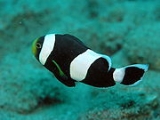
Saddleback clownfish
Encyclopedia
The saddleback clownfish, Amphiprion polymnus, also known as the saddleback anemonefish is a member of the family
Pomacentridae
.
and the Western parts of the Pacific
ocean
s. Like most clownfish, they are most often observed living in a symbiotic relationship with a host anemone
for protection and in the wild are most often seen in association with Stichodactyla haddoni (Saddle carpet anemone) or Heteractis crispa (Sebae anemone).
with a third white bar or margin located across the caudal peduncle (pictured in taxobox).
Melanistic variation has also been partially correlated with the fish's host anemone. Specimens associated with H. crispa tend to be darker than those associated with S. haddoni. Aquarium specimens have been observed becoming lighter or darker after accepting a new host anemone species, sometimes within a few hours.
They can reach a maximum length of 12 cm.
s or larger, preferably aquascaped with live rock
to allow multiple choices for hiding places. They should be fed small amounts of food, such as staple marine flake food with occasional frozen mysis shrimp or other small crustacean, two to three times per day.
The protection of a host anemone is not required in an aquarium and attempting to keep either of the species of anemones commonly associated with this clownfish in a captive aquarium environment is not recommended, even for experienced aquarists. This is due to the poor survival rate of wild collected specimens and the overall shortened lifespans these normally centarian organisms often experience in captivity.
Family (biology)
In biological classification, family is* a taxonomic rank. Other well-known ranks are life, domain, kingdom, phylum, class, order, genus, and species, with family fitting between order and genus. As for the other well-known ranks, there is the option of an immediately lower rank, indicated by the...
Pomacentridae
Pomacentridae
Pomacentridae are a family of perciform fish, comprising the damselfishes and clownfishes. They are primarily marine, while a few species inhabit freshwater and brackish environments . They are noted for their hardy constitutions and territoriality...
.
Habitat
The saddleback clownfish can be found in the eastern parts of the IndianIndian Ocean
The Indian Ocean is the third largest of the world's oceanic divisions, covering approximately 20% of the water on the Earth's surface. It is bounded on the north by the Indian Subcontinent and Arabian Peninsula ; on the west by eastern Africa; on the east by Indochina, the Sunda Islands, and...
and the Western parts of the Pacific
Pacific Ocean
The Pacific Ocean is the largest of the Earth's oceanic divisions. It extends from the Arctic in the north to the Southern Ocean in the south, bounded by Asia and Australia in the west, and the Americas in the east.At 165.2 million square kilometres in area, this largest division of the World...
ocean
Ocean
An ocean is a major body of saline water, and a principal component of the hydrosphere. Approximately 71% of the Earth's surface is covered by ocean, a continuous body of water that is customarily divided into several principal oceans and smaller seas.More than half of this area is over 3,000...
s. Like most clownfish, they are most often observed living in a symbiotic relationship with a host anemone
Sea anemone
Sea anemones are a group of water-dwelling, predatory animals of the order Actiniaria; they are named after the anemone, a terrestrial flower. Sea anemones are classified in the phylum Cnidaria, class Anthozoa, subclass Zoantharia. Anthozoa often have large polyps that allow for digestion of larger...
for protection and in the wild are most often seen in association with Stichodactyla haddoni (Saddle carpet anemone) or Heteractis crispa (Sebae anemone).
Appearance
Color ranges from dark brown to yellow orange with a thick white bar located just behind the eyes. A large white abbreviated saddle shape or slanted white bar across the middle of the fish's body makes it quite obvious to see how it got the name Saddleback . In some varieties, typically those specimens initially associated with H. crispa anemone, the saddle shape may extend up onto the fish's Dorsal finDorsal fin
A dorsal fin is a fin located on the backs of various unrelated marine and freshwater vertebrates, including most fishes, marine mammals , and the ichthyosaurs...
with a third white bar or margin located across the caudal peduncle (pictured in taxobox).
Melanistic variation has also been partially correlated with the fish's host anemone. Specimens associated with H. crispa tend to be darker than those associated with S. haddoni. Aquarium specimens have been observed becoming lighter or darker after accepting a new host anemone species, sometimes within a few hours.
They can reach a maximum length of 12 cm.
Captivity
To be kept in an aquarium this species will do best in tanks of at least 30 gallonGallon
The gallon is a measure of volume. Historically it has had many different definitions, but there are three definitions in current use: the imperial gallon which is used in the United Kingdom and semi-officially within Canada, the United States liquid gallon and the lesser used United States dry...
s or larger, preferably aquascaped with live rock
Live rock
Live rock is rock from the ocean that has been introduced into a saltwater aquarium. Along with live sand, it confers to the closed marine system multiple benefits desired by the saltwater aquarium hobbyist...
to allow multiple choices for hiding places. They should be fed small amounts of food, such as staple marine flake food with occasional frozen mysis shrimp or other small crustacean, two to three times per day.
The protection of a host anemone is not required in an aquarium and attempting to keep either of the species of anemones commonly associated with this clownfish in a captive aquarium environment is not recommended, even for experienced aquarists. This is due to the poor survival rate of wild collected specimens and the overall shortened lifespans these normally centarian organisms often experience in captivity.

